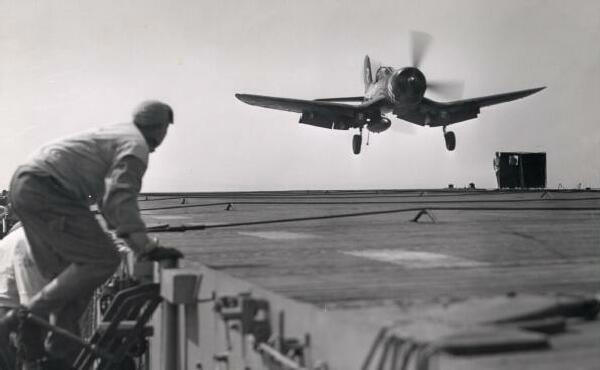|
|
|
PLANE 007 Level 3 |
|
 |
|||||
|
|
This plane's most unique feature was the "bent" wing, the result of a marriage between the most powerful engine ever installed in a piston-engined fighter and one of the biggest propellers in the world. The inverted gull wing permitted the short, sturdy undercarriage required for carrier operations, allowed a low drag, 90 degree wing-fuselage junction, gave the pilot better visibility over the wing and lowered the overall height of the folded wing. Its distinctive sound was caused by the wing-root inlets for the engine air. A production contract was awarded to the manufacturer in June 1941 and the first production machine flew in June 1942 with a top speed of 415 mph, a sea-level climb rate of 3,120 ft/min and a service ceiling of 37,000 ft. The first carrier trials were carried out in September 1942 aboard the USS Sangamon. Despite the hundreds of detailed demands contained in the specifications for the new fighter plane, the major design objective was speed - - and more speed; everything else was secondary. From the start of its design in June 1938 the paramount demand on the Corsair was that it be the fastest fighter ever built and this goal was achieved when the new plane became the first in the world to exceed 400 mph in level flight with full military equipment. Two things are required to create the rare environment in which a seemingly ageless airplane can exist: 1.) It must be a very good airplane; and 2.) The peculiar economic or tactical situation into which it was borne must persist. This airplane met both of these environmental tests. It was one of the fastest propeller-driven airplanes in the world and its unmatched versatility included close air support abilities vital to a successful war effort. This plane was one of the great fighter plane designs of WWII. A rugged piece of flying machinery, it had the most durable production of all fighters of that day. From the first prototype delivery to the U.S. Navy in 1940, to final delivery in 1953 to the French, 12,571 F4U's had been manufactured. First ordered into
production in the fall of 1941, these planes appeared in time for the
bitter struggle in the southwest Pacific from Guadalcanal to VJ Day.
Until late 1944, both Navy and the Marines had used it as a land-based
fighter. In the final year of the war, it began operations from aircraft
carriers, where it speedily ran up new spectacular scores. |
|